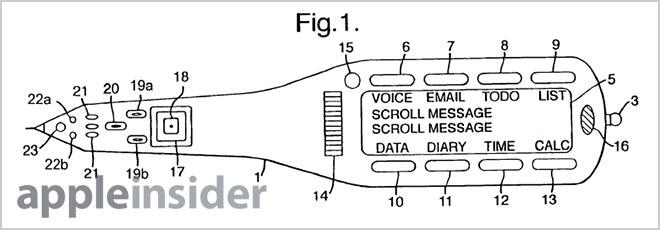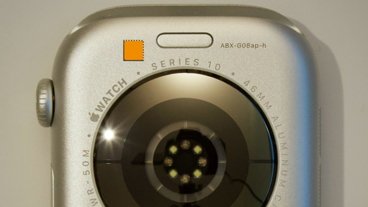The U.S. Patent and Trademark Office on Tuesday reissued Apple a patent for a mobile computer encased in a pen, adding cellular and GPS capabilities to the invention first filed for internationally in 1998.
Simply titled "Portable computers," the invention, originally assigned to British Telecommunications PLC, describes a multifunction device equipped with a pair of accelerometers to recognize handwritten input, a built-in display and an embedded touch strip for GUI navigation.
When Apple was transferred the U.S. patent rights in 2008, the invention was already assigned U.S. Patent No. 6,956,564. As of Tuesday, it carries the reissued designation of RE44,103 and broadens the patent language of the first filing while relating it to another property covering identical technology granted in 2011.
Most important of the additions is the possibility of cellular or wireless data transmission through an onboard radio. The patent adds 11 claims to the original 36, each applying the words "cellular telephone" to the previous assertions, while one embodiment includes GPS positioning technology.
Image of cell tower, GPS and device as added with reissued patent.As noted in the patent language, the invention was meant as an alternative to the then-current palm top computers (PPCs) which often took on a clamshell form factor with an integrated keyboard. Apple's invention provides for a portable computer with the same functionality of PPCs, but in an ergonomic chassis that fits comfortably in the user's hand.
The patent does away with the need for a bulky keyboard as the device has various sensors disposed throughout its body to detect hand movements, such as tilt and acceleration, which is then output as alphanumeric or graphical data.
Profile of pen computer.From the patent summary:
According to the present invention there is provided a portable computer including movement detection means responsive to movement of the computer to produce an electrical output signal representative of such movement, processing means responsive to the output of said position detection means to determine detected movement data defining a user's intention, the processing means using said data to provide a mode response selected from a multiplicity of stored possible modes.
The built-in LCD screen is flanked by either pressure or touch sensitive multifunction buttons and a touch strip to navigate through written messages or other stored information. In another embodiment, the stylus body itself can be used to move through the on-screen data by tilting the unit away or toward the user. As is the case with the iPhone, the display orientation can be locked in either portrait or landscape mode.
Also incorporated into the numerous sensors already disposed throughout the pen body is a proximity sensor that can adjust font size based on how far away the device is from a user's eye line. This technique is further used to determine what hand the pen is in, thereby allowing on-screen text to be flipped accordingly.
Block schematic.Interestingly, the patent calls for an ARM processor, the same micro-architecture Apple uses in its A-series SoCs.
Finally, the device can support sound input/output components that can be used to process speech-to-text and text-to-speech.
Various embodiments include docking stations, infrared data transmission and mouse simulation through surface sensors. The device can support full PDA functionality, such as email correspondence and storage of a contacts list.
While the "portable computer" is 15 years old, many of its technologies are being employed in Apple's latest iOS products like the iPhone and iPad. Indeed, some of the proposed hardware and software solutions go beyond what is offered on the modern consumer market. Perhaps most intriguing is the broadening of the patent to include cellphones, possibly suggesting that handwriting recognition or some other facet of the invention may make its way to a future iOS device.
Apple's patents was first applied for in Great Britain in 1997 and credits Hilary Lyndsay Williams as its inventor.
 Mikey Campbell
Mikey Campbell




-xl-m.jpg)


-m.jpg)






 Chip Loder
Chip Loder
 Thomas Sibilly
Thomas Sibilly
 Wesley Hilliard
Wesley Hilliard
 Christine McKee
Christine McKee
 Amber Neely
Amber Neely
 William Gallagher
William Gallagher
 Malcolm Owen
Malcolm Owen









22 Comments
Talk to the hand, cos' my pen does not want to hear !
(duplicate, sorry)
Sometimes I wonder why people can't see past the awful diagrams or title of a patent to see more elegant and prolific uses than stated. This time, I can't see any and I can't rule out the at ugly ass pen as the reason why. I'm all for a proper digitizer pen as non-included option for an iPad (which of course would all come with the wacom digitizer and API support in Xcode) but this just looks awful. It would look more at home with pudding pop stains and a bumblebee on it.
Pen? That much bigger? Oh no!
[quote name="SolipsismX" url="/t/156665/apples-reissued-pen-computer-patent-adds-cellular-connectivity-could-hint-at-future-mobile-device#post_2300442"]Sometimes I wonder why people can't see past the awful diagrams or title of a patent to see more elegant and prolific uses than stated. This time, I can't see any and I can't rule out the at ugly ass pen as the reason why.[/quote] That being the case, I would say it was a well written patent application. Clarity with lashings of obfuscation are the order of the day with patents - particularly the illustrations. Given the typical elapsed time twixt applying for and being granted, the one thing you don't want to give away, is any clue to the final form factor. It also works the other way round - you may not want your patent to be limited or 'narrowed' by overly exact language that allows your competitors to copy your IP by simply making small changes to either the form factor or the implementation. As a general rule, the more [I]unique[/I] the patent is, the broader the language used becomes... the stronger the patent becomes in future i.e. easier to defend with less claims construction narrowing in any subsequent court actions. Regarding this particular patent, I'd hazard a guess that Apple have recognised some weaknesses in the original and voluntarily narrowed its scope by by adding some more precise claims.